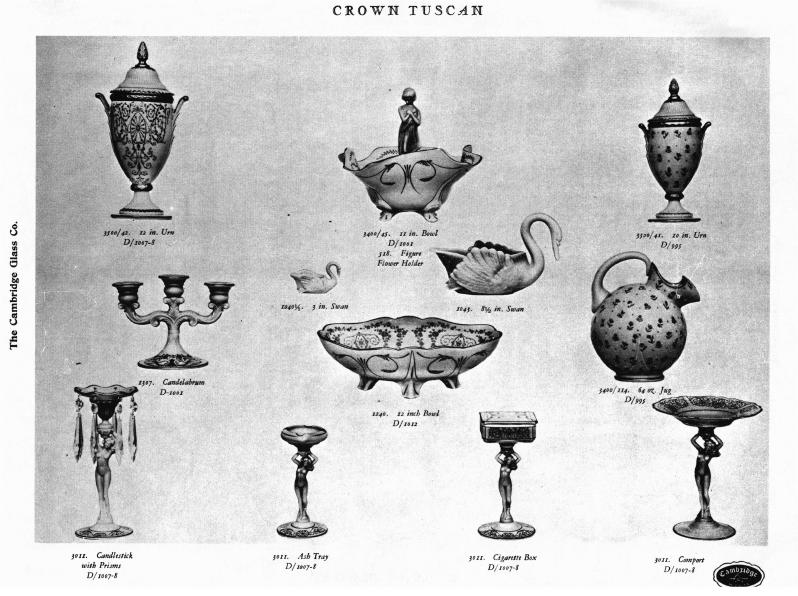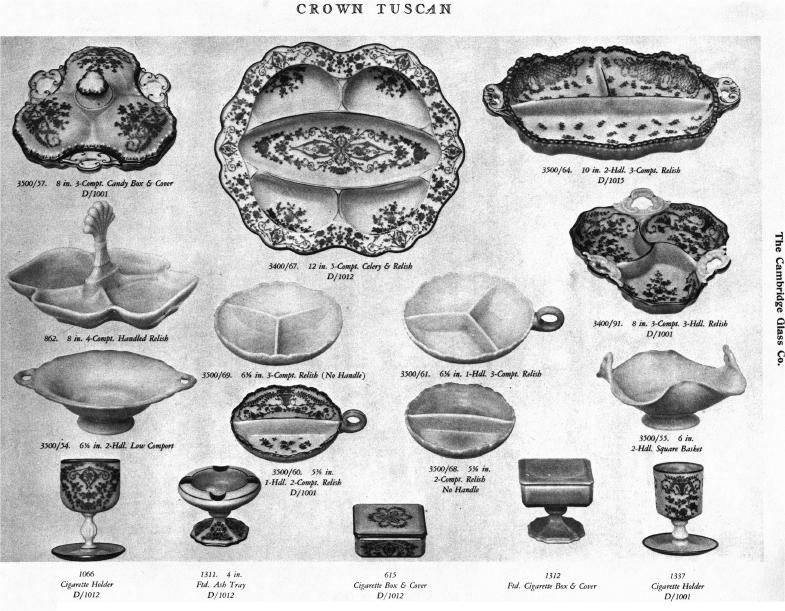Crown Tuscan, Part I - The Early Years
by Mark A. Nye
Issue No. 154 - February, 1986
"The Chicago showrooms of Cambridge Glass Co. are displaying the 'Crown Tuscan' line which has been received with much interest since its recent announcement. This opaque glass with its rich cream-like color is offered in a wide choice of fancy and table pieces including vases, bowls, side dishes, ball jugs, etc. This Cambridge line carries a hall-mark on the bottom of each piece after the manner of dinnerware. This hall-mark consists of a crown with the name 'Tuscan.'" China, Glass & Lamps, September 1932.
The preceding is probably one of the first, if not the first, report of Crown Tuscan to appear in the trade publications. From it one can deduce Crown Tuscan most likely went on display in Cambridge showrooms in late Summer 1932, perhaps even in early to mid-August. Two other trade reports, one from February 1933 and the other undated, depict Crown Tuscan thusly:
"Crown Tuscan - A whitish pink opaque glass in vases, bowls and fancy pieces for table and home decoration. Shown plain or with color band at edge."
"Crown Tuscan - This is a new pinkish ivory translucent glass somewhat resembling a very high grade china. This glass takes on a very high fire polish and the colorings in each piece vary slightly in an interesting manner."
To quote further, this time from the NCC book Colors in Cambridge Glass:
"It (Crown Tuscan) is a pinkish color that will range from near transparent to opaque in density and is sometimes described as being 'near flesh color.' It is found in a wide range of shades from a dark tan through shades of pink to almost white. Some pieces show streaks that approach a very high degree of fire polishing which could result in a show of opalescence near the edges."
Using these descriptions, the reader should be readily able to visualize the Cambridge color known as Crown Tuscan.
The opening quote describes quite well the range of items produced in Crown Tuscan during the early years. Two pages of the 1933 Cambridge catalog supplement were devoted to Crown Tuscan and one of these illustrated nothing but cases, 12 to be exact. All were decorated with gold D/1007 (Lace Design) or a gold encrusted etching, including Diane and Portia. Other items in Crown Tuscan shown in 1933 included the #1040 3½" swan, the 1043 8½" swan and four items from the Nude line, candlestick, ashtray, cigarette box and comport, all with D/1007-8.
The 1934 catalog supplement contained four pages of Crown Tuscan ware. Again, much of what is shown is decorated and now we find gold encrusted Minerva or D/1015 on Crown Tuscan Gadroon (#3500 line) blanks. In addition to the #3500 line, blanks from the #3400 line, the Tally-Ho line, the #3011 or Figure Stem line, as well as miscellaneous items from the other lines, were also being shown in Crown Tuscan.
(Editor's Note: For purposes of illustration we refer you to the NCC 1930-34 Catalog Reprint, pages 33-30, 33-31, and 34-9 through 34-12.)
Bowls, plates, relishes, smokers items, along with vases, comports, a decanter and sherry glass, a basket, a jug, ice pail and candleholders were among the Crown Tuscan items in the 1934 Cambridge line. The smokers items included: two cigarette holders, #1066 and #1337; two cigarette boxes, the #615 and the #1312 footed box and cover; and the #1311 footed ashtray.
One of the four pages in the 1934 Cambridge catalog supplement pictured Crown Tuscan items with an Ebony foot. Numbered in this grouping were three items from the #3011 (Nude Stem) line; the cigarette box and cover; the ash tray; and the 7" comport. Shown also were two items from the #1066 line; the cigarette holder; and the 5 3/8" comport; as well as smokers items from other lines; and four vases, #274, #1283, #6004 and #1300.
It was only during these early years of production that the Crown Tuscan trade mark was used. It is questionable whether every piece produced in Crown Tuscan was signed as stated in the opening quote. Dave Rankin, in his excellent series on Trademarks (published in the Crystal Ball some years ago), discussed the use of the Crown Tuscan mark. His comments are repeated here.
"Our final trademark was applied to some Crown Tuscan pieces. Trade advertising tells us that Crown Tuscan was introduced in the fall of 1932.
Examination of existing Cambridge color books reveals that this acid stamp signature appears predominately on 3400 line items, also on Gadroon (3500) and Statuesque (3011). Frequent decorations on these pieces are Diane (D/1012), Chintz (D/995), Portia (D/1001) and a lace type decoration (D/1007-8).
Each of these lines and decorations appears on two pages in the 1933 addition to the 1930-34 Cambridge catalog in the club's possession. It was also noted in this examination of the color books that the mark did not appear on Seashell pieces (new in 1935) or on pieces decorated in Rose Point (introduced in November, 1934) or on later lines. This suggests that usage of the Crown Tuscan acid stamp was limited to the years 1932-34." (Cambridge Crystal Ball, April 1976.)
To add to David's comments, it is highly unlikely blanks sold to decorating companies would have carried the Crown Tuscan trademark.
In addition to lines previously mentioned, the 1930s saw blanks from such other lines as Nautilus and Everglades as well as such objects as the Mannequin head made in Crown Tuscan. It would be indeed foolhardy to flatly state any given item was not made in Crown Tuscan during those years. Of course, not every line or mold was produced in Crown Tuscan, but what is true is that it is conceivable Cambridge could have at least tried most items in Crown Tuscan during the 1930s. For the most part, stemware will be an exception to this as will tumblers and decanters but examples of these are known.
Among the most notable exceptions to no Crown Tuscan stemware, are the Crown Tuscan Nude cocktails, first made during the 1930s. With a Crown Tuscan nude stem and foot, these cocktails were made with bowls in colors of: amber, amethyst, carmen, forest green, gold krystol and royal blue. This grouping of Crown Tuscan nude cocktails had been dropped from the Cambridge line by the end of the 1930s.
Cambridge introduced the Sea Shell line in 1935 and with it came one of the Cambridge color controversies. I am speaking of the color name Coral. Rather than "reinvent the wheel," I again quote from Colors in Cambridge Glass.
"Coral was introduced in February 1935, as one of the colors of the Sea Shell line. No substantial evidence has been found to indicate that this was a distinct color formula. It is probable that this color name was coined by the sales department of the company as being a more appropriate name to apply to Crown Tuscan when used in the 'Sea Shell' line.
When the Sea Shell line was introduced, one author described Coral color as a 'shade with a tinting of coral on bluish white.' He was describing the blue opalescent appearance of the thinner sections characteristic of some items in the Sea Shell line. This has lead some collectors to debate whether coral was a unique color formula. Nevertheless, the name Coral was not used outside the Sea Shell line. The Crown Tuscan name was not applied to the Sea Shell line until 1949 when Cambridge had stopped using the Coral name and used the Crown Tuscan name on all lines."
For color pictures of Crown Tuscan and Coral, the reader is referred to Plates 35, 36 and 37 in Colors in Cambridge Glass. Readers desiring more information about the Sea Shell line are referred to Lynn Welker's excellent article on this topic published in the February 1978 issue of the Cambridge Crystal Ball.
It was during the mid-to-late 1930s Abels, Wasserberg & Co., Inc. of NYC began using Crown Tuscan and Coral blanks as bases for hand painted decorations known as "Charleton." Collectors tend to forget these pastel decorations were not done by Cambridge. Cambridge simply provided the blanks to the decorating company.
To be continued ...


